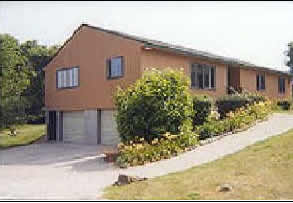
III. Your Home and Stormwater: Things you can do.
| Test Your Knowledge | |
|---|---|
 |
How many sources of stormwater pollution are there in the average home? Click the "start" button to see some of the answers. |
Most practices currently used to manage stormwater tend to move the stormwater off of a site as quickly and efficiently as possible, and deal with managing the quantity or quality of the stormwater at the end of the pipe. This method has a number of disadvantages to our environment. Most importantly, by moving the stormwater off of the site, it is no longer available to replenish the groundwater. A different technique for managing stormwater, called low impact development (LID), has been pioneered by the Prince George County Planning Department. LID seeks to preserve the natural, pre-development conditions of a development by using one or more small stormwater BMPs on each individual site, rather than one large BMP at the end of the pipe.
| A Sample of LID practices: |
|---|
|
Managing Household hazardous products
1. Proper disposal of materials
Would you drink a cup of oven cleaner? Of course not. But did you know that when you pour something down your sink's drain, that eventually it will end up in your drinking water? That's because you are in a watershed and what you dispose in it ends up in your groundwater, streams, lakes, and New York City reservoirs. That's why proper disposal of household cleaners and other products is so important. Many products found in the home contain chemicals which are potentially harmful to people, and need to be disposed of properly. Protect your private well, your public wells, and water supply of your neighbors.
| Common Hazardous Products Found in the Home: |
|---|
|
2. Patterson Recycling Center
The Town of Patterson offers aggressive recycling programs. Information on the curbside pickup and dropoff programs is available on the Town of Patterson Website, or by calling the Patterson Town Clerk's Office at 845-878-6500.
3. Putnam County Hazardous Waste Cleanup
For the past several years Putnam County, NYS DEC, and NYC DEP have jointly sponsored a Hazardous Waste Cleanup Day, giving Putnam County residents a place to take their household hazardous waste. For this special cleanup event Putnam County terms a household hazardous waste as any household product used for cleaning, gardening, home hobby supplies, pesticides, automotive products, and cosmetics such as nail polish remover and hair dyes, which if improperly disposed of, may result in pollution of the environment or injury to the public. In the past, disposal has been free and available to Putnam County residents only (no commercial establishment waste is accepted).
A properly designed, constructed and maintained septic system can provide long-term effective treatment of household wastewater. However, if not maintained, your septic system may eventually fail, and release improperly treated wastewater to the surface. Repairing a failed septic system could end up costing you thousands of dollars. Protecting water quality is important. The motivating reasons for you to maintain your system is to save money on the costly repair work and protecting your health.
A typical septic system has two main components: a septic tank and a drainfield. Wastewater from your home travels through a pipe into the septic tank where solids settle out and oils and grease float to the surface. Wastewater exits the septic tank and is discharged into the drain fields. As the wastewater infiltrates through the soil microbes digest or remove most contaminants from the wastewater.
Properly operating septic systems will effectively reduce or eliminate most human or environmental threats posed by pollutants in household wastewater. However, septic systems do require periodic maintenance to ensure that they continue to function properly.
| Help Your Septic System Continue to Function Properly: |
|---|
|
Stormwater can become contaminated from excessive or improper use of pesticides, herbicides and fertilizers. Maintaining landscaped areas properly can help prevent fertilizers, pesticides, soil and grass clippings from polluting the watershed. Improper landscape practices can result in excess amounts of nitrogen, phosphorous, and other nutrients, pesticides, and herbicides, from discharging to the area's surface water.
| You Can Minimize or Even Eliminate the Amount of Chemicals and Other Material that Enters Storm Drains: |
|---|
|
One of the most important landscape features which minimize the impacts of stormwater are the trees. Trees intercept the rain falling from the sky, slowing its velocity, which in turn reduces soil erosion. Trees also retain a small amount of the rainfall on their leaves. The leaf litter on the forest floor promotes better infiltration of rainfall into the ground.
Underground storage tanks, used for the storage of home heating oil or other petroleum products, poses a very serious concern for both groundwater and surface water. These storage tanks corrode over time and ultimately begin leaking petroleum into the ground. A leaking storage tanks may go unnoticed for years until contaminants appear within a drinking water source (well), or when a breakout to surface water is observed. When a leak occurs the clean-up costs potentially could run into tens of thousands of dollars.
New York State currently provides a tax credit for the removal of a residential underground petroleum storage tank and installation of its replacement. Tanks must have been removed or permanently closed on or after April 1, 2002, and a replacement tank must be installed before January 1, 2004. The credit is equal to the lesser of the cost of the removal and replacement, or $500.
| Additional Sources of Information: |
|---|
| Test Your Knowledge Again | |
|---|---|
 |
Now that you've had a chance to learn about the sources of stormwater pollution in and around your home, let's review some ways they can be eliminated. Click the "start" button to see some of the solutions. |